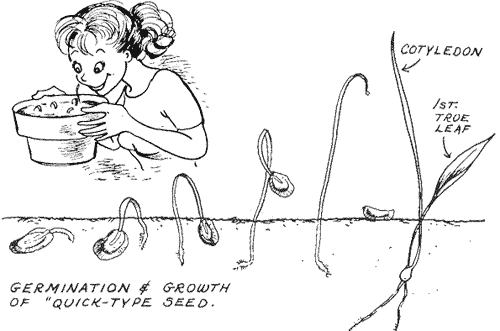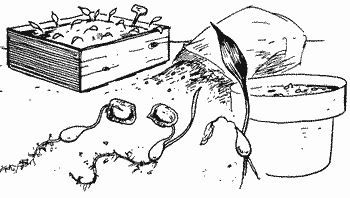You probably think that lilies will take years and years to grow from seed because they are so big and beautiful but they don’t. Some will bloom in only 18 months if the proper procedure is followed.
Epigeal or “quick-type” seed
It is best for beginners to start with the epigeal or “quicktype” seeds. They can be planted directly in prepared ground or in a cold frame, but much quicker results are possible with windowsill or fluorescent light culture.
Many kinds of containers may be used but from four to six inches deep is best. Most amateurs find plastic pots ideal. Holes for drainage are a must with an inch or so of pebbles or other rough material at the bottom of the pot for drainage. If you have planted seeds indoors before, you will have your own favorite planting medium. Alternatively, you can use a light, fluffy potting mix containing vermiculite. These mixes, sold in stores, are good and usually are sterile. Some gardeners use soil to almost fill the container, and then add a thin layer of milled sphagnum for the seeds to lie on, and then cover with more of the same material. Lily seeds are quite large and should be spaced about one-half to one inch apart. If sphagnum is used to cover, sprinkle with a fine spray of water. The whole container should be thoroughly soaked by setting it in a pan of water for several hours. Be sure to label your plantings before forgetting to do so! After allowing excess water to drain away, cover the container with plastic or enclose in a polyethylene bag, and store in a warm place.
If good fresh seed is used, the seedlings should start to appear in as early as 14 days and maybe sooner. Remove the plastic as soon as the first “hairpin” shoot shows and place in good light. Fluorescent lights work very well if your windowsills are crowded. Water and light are all the seedlings will need for awhile. When most of the seed has sprouted, you may start feeding about every two weeks with dilute liquid fertilizer; organic fish oil is good.
These first grass-like leaves are called cotyledons. The true leaves which are broader, will appear in about four more weeks and in fairly rapid succession from then on.
Hardening Off Seedlings grown indoors will need to adjust to the brighter light and cooler temperatures before planting out. A protected place, out of the wind and full sun for a couple of weeks, should condition them for their new outdoor life.
 The tender, loving care you give your seedlings while they sojourn in the nursery will play a big part in the number of blooms that they will reward you with in their second summer. Let nothing check their growth! Water regularly; feed at least once a month until late summer with a liquid organic fertilizer such as fish oil. Keep down weeds, preferably with mulch, and spray with a fungicide as a good precaution against botrytis which might destroy the leaves.
The tender, loving care you give your seedlings while they sojourn in the nursery will play a big part in the number of blooms that they will reward you with in their second summer. Let nothing check their growth! Water regularly; feed at least once a month until late summer with a liquid organic fertilizer such as fish oil. Keep down weeds, preferably with mulch, and spray with a fungicide as a good precaution against botrytis which might destroy the leaves.
When frost has blackened the leaves, about two inches of good soil may be added to the seedling bed. As soon as the ground is frozen, a thick mulch of pine needles, straw, salt hay, etc. should be spread over all.
When spring arrives, watch the beds carefully and when the spring sun begins to warm the ground, and the shoots start to appear, carefully remove the mulch . . . but keep it piled nearby to cover the lilies if frost threatens. A fertilizer rich in nitrogen may be scratched in at this time . . . and again at about the time buds first show.
First Blooming!
This is what you have been waiting for, isn’t it? About June the promising fat buds, sometimes one but often times as many as three or four, will begin to appear. I don’t have to tell you to watch now. You’ll be down in that seedling patch many times a day! These firstblooming lilies with their huge blooms on short slender stems are beautiful! Next year they will be taller, sturdier and have many more blossoms. Aren’t you glad we persuaded you to grow some from seed? How long did it take? Only 18 months. That doesn’t seem possible, does it?
Hypogeal or “slow type” seed
Not all lilies grow as rapidly as trumpets, Aurelians, Asiatics, L. pumilum, and all the other “quick-type” lilies. It is not that the hypogeal or “slow-type” seeds are much more difficult but you do need patience! If you must try some of these types too then we’d better give directions for hurrying them along as much as possible.
 These seeds have a two-stage germination process. First is the warm period. Disinfect the seed with a fungicide, mix with a generous handful of damp peat moss, milled sphagnum or vermiculite, enclose in a polyethylene bag, label and fasten. Store this in a warm place for approximately three months. Late May or early June planting ensures the most uniform germination. By peeking occasionally you can see little bulblets forming after the second month or so.
These seeds have a two-stage germination process. First is the warm period. Disinfect the seed with a fungicide, mix with a generous handful of damp peat moss, milled sphagnum or vermiculite, enclose in a polyethylene bag, label and fasten. Store this in a warm place for approximately three months. Late May or early June planting ensures the most uniform germination. By peeking occasionally you can see little bulblets forming after the second month or so.
When most bulblets have swelled and made little roots, store the bag, still securely fastened, in the refrigerator for two to three months more. They may remain refrigerated longer or over winter for your convenience. After this cold period, the little bulblets may be tenderly planted and cared for as you do the “quick-type” seeds. The first true leaf will appear in a week or two. Take good care of it! It may be the only one produced for a whole year. These seedlings are best pampered in a shaded cold frame for a year or two. It will be three or four years before you reap your reward on these! But the “slow-type” lilies are some of our most breathtakingly beautiful and desirable such as the radiantly rosy L. speciosum and L. auratum hybrids as well as petal-pink L. japonicum and L. rubellum. If you grow and flower one of these from seed, your heart will really flutter with pride!